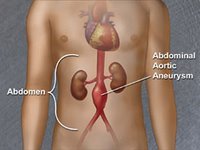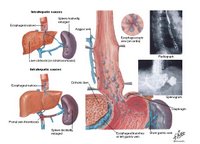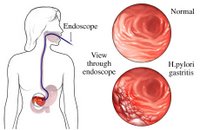| Some Stuff |
|
| Some MORE Stuff |
|
|
| Aortic Aneurysm |

The aorta is a large artery arising from the heart and carries blood to the rest of the body. Aortic aneurysm is an abnormality of a localized area of the aorta characterized by widening or ballooning of the abnormal site. It commonly occurs in the abdominal aorta or the part of the aorta below the diaphragm. It is usually seen below the renal arteries which are the blood vessels going to the kidneys. Abdominal aorta supplies blood to the abdomen and the lower part of the body. This condition is common in males above 60 years old. The bigger the aneurysm, the greater the likelihood of rupture. It is life-threatening when it ruptures.
The exact cause of this condition is unknown. Some attribute it to the hardening of the arteries known as arteriosclerosis which causes weakness of the aortic wall. Cigarette smoking increases risk of developing the condition together with high blood pressure, high cholesterol levels, and obesity. Other causes include arteritis, genetic, connective tissue disease, and mycotic infection.
This condition is asymptomatic to most individuals. That’s why it is only discovered as an incidental finding when abdominal ultrasound or a CT scan is done for other conditions. When they do become symptomatic, pain is the most common symptom felt at the lower back or lower abdomen. The pain is described as severe, sudden, and may radiate to the groin, buttocks, or legs. There is also a pulsating sensation felt in the abdomen.
If the aneurysm is less than 5.5 cm wide and asymptomatic, periodic monitoring is usually done. But if it is more than 5.5 cm in diameter with symptoms and monitoring shows that it is rapidly increasing in size, rupture is common. Surgical repair is then recommended. |
|
|
|
| Pancreatitis |

The pancreas is a flat, non-encapsulated gland located behind the stomach (retroperitoneal). It functions by producing enzymes and digestive juices needed for breaking down food in the small intestines and it also produce hormones called insulin and glucagon that control levels of blood sugar. These secretions of the pancreas coming from the cells are brought to the ducts which leads to the main pancreatic duct. The common bile duct joins the main pancreatic duct and then empty into the duodenal part of the small intestines. One of the common causes of pancreatitis is the presence of gallstones that obstruct the flow of pancreatic secretions that should empty into the small intestines. Obstruction causes these secretions to attack the gland itself thus causing inflammation. Another common cause is chronic use of alcohol which causes the pancreatic enzymes to be secreted earlier than normal accompanied by leakage of pancreatic secretions into the glandular tissue and cause damage and inflammation. Other causes of pancreatitis include increased triglyceride and calcium levels in the blood, pancreatic abnormalities, trauma, infections, and certain medications. All these lead to damage and inflammation of the pancreas. Healing without functional impairment is known as acute pancreatitis. If the problem becomes recurrent this is now known as chronic pancreatitis. Chronic pancreatitis often leads to poor absorption of fats producing oily malodorous stools. There is also damage of the pancreatic cells which normally secretes insulin. This now leads to improper metabolization of blood sugar which contributes to diabetes. The most common symptom of pancreatitis is epigastric pain often radiating to the back. This is accompanied by nausea and vomiting, and fever. If the condition is severe there can be low blood pressure because of internal bleeding and which may lead to shock. A patient in this condition needs to be hospitalized and hooked in IV fluid. Nothing should be given per orem for several days and the pain should be controlled. |
|
|
|
| Esophageal Varices |

The portal vein is the blood vessel inside the liver which carries blood coming from the intestines and spleen to the liver (splanchnic circulation). When the portal vein becomes obstructed due to certain liver conditions such as cirrhosis, the pressure inside the blood vessel increases. This problem leads to development of collateral circulation diverting the obstructed blood flow to the systemic veins. The esophageal veins which drain into the azygos vein are common collaterals in which blood are diverted into. Hence, esophageal varices develop. These are usually found in the lower esophageal walls and sometimes in the upper part of the stomach. These varices often cause no symptoms unless they rupture and bleed making the condition life-threatening. Their rupture leads to vomiting of blood and passing out of black, tarry stools. When untreated this will lead to symptoms of thirst, decreased urine output and paleness. On physical examination, there is rapid heart rate and low blood pressure. There may also be signs of liver disease. Aside from liver cirrhosis which is the most common cause of portal hypertension, other causes include formation of blood clot in the potal vein (thrombosis), and congestive heart failure. Management is usually done inside the hospital using medical and procedural therapies. The most important goal is to stop and control the bleeding before shock or death occurs. |
|
|
|
| Gastritis |

Gastritis is not a single disease process but a group of disorders that involve inflammation of the stomach lining. It result from chronic use of pain relievers such as NSAIDS in some individuals or it may be due to a bacterium that is causing most ulcers in the stomach. This condition may occur suddenly (acute gastritis) or it may develop gradually (chronic gastritis).
The most common symptom is upper abdominal pain characterized by a burning sensation and usually noted with intake of food. This is often accompanied by nausea, vomiting, belching, a feeling of fullness which often leads to weight loss when the condition becomes chronic. In some individuals, gastritis increases risk for ulcer formation and stoamch cancer. In these group of individuals, gastric bleeding is common.
The main cause of gastritis is damage to the mucosal lining of the stomach. With damage there is lost of the normal mucous barrier that serves to protect the stomach lining from irritation and inflammation. One of the many factors that contribute to the damage of this protective stomach lining is chronic use of pain relievers known as NSAIDS. This is exemplified by iboprofen and aspirin. Other factors include excessive use of alcohol, stress, bacterial infection (H. pylori) which is also the number 1 cause of stomach ulcers, and a list of autoimmune disorders like Crohn’s disease. Radiation and chemotheraphy is also contributory.
Knowing the cause of the condition makes prevention easier. If there is really a need for use of pain relievers, use acetaminophen instead. Avoid alcohol and eat in smaller amount but in higher frequency with avoidance of spicy and fatty foods. It is also important to eat regularly at meal times. Manage stress and have a regular exercise that you enjoy. This will allow you to move your waste through the intestines regularly. |
|
|
|
| GAstroenteritis |

The gastrointestinal tract is responsible for the digestion of food. This tract starts from the esophagus down to the anus. When this tract gets inflammed because because of viral, bacterial, or parasitic cause, the problem results in gastroenteritis. The infection usually results from intake of contaminated food and water or contact with an infected person. Handling of food without hand washing or using dirty kitchen utensils in the preparation of food facilitate transmission of virus or bacteria.The most common symptom is diarrhea. The inflammed colon loses its ability to absorb needed nutrients so that whatever is taken in is also passed out. Diarrhea may be accompanied by low-grade fever, abdominal pain, bloating, nausea, and vomiting. The lost fluids should be replaced by giving oral rehydrating solutions. If not, dehydration may set in and manifests as cold clammy skin, excessive thirst, dry mouth, and sunken eyes. Aside from fluid replacement theraphy, avoiding dairy and milk products, caffeinated and alcoholic beverages, fatty and spicy foods help improve the condition. Eat only easy-to digest foods in small proportions. This condition is usually seen in travelers and individuals who take most of their meals in fastfoods (carinderias). In order to avoid having the condition, always wash hands after using the toilet and whenever you handle food. Also, refrain from eating raw or slightly cooked food, avoid ice cubes, and always drink bottled water when travelling. |
|
|
|
|
|